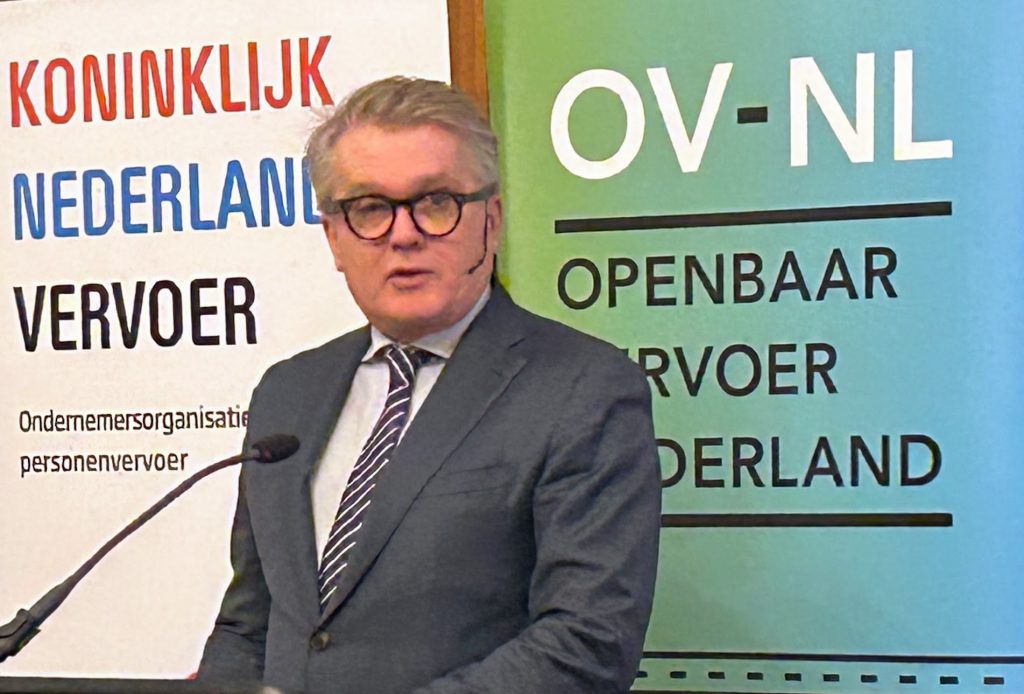Should KNV play a more positive role in the sector and contribute to improving the situation in student transport?
The criticism of Royal Dutch Transport (KNV) about student transport is increasing after another year of imbalance between supply and demand. Chairman Bertho Eckhardt, who attended the Student Transport Day called for urgent consultations between involved parties, emphasizing the urgency to prevent incidents in the 2024-2025 school year. The persistent capacity shortage, referred to as 'a new reality' by KNV, remains a challenge.
Increasing criticism of the trade organization KNV itself by its own members is also a sign of growing frustration and dissatisfaction within the sector. The fact that the sector itself currently offers few concrete solutions and is mainly limited to identifying problems and issuing warnings, may point to a number of underlying challenges and areas that require attention where KNV can help.
KNV itself can proactively enter into dialogue with all stakeholders, including municipalities, schools, parents and drivers, to jointly discuss and solve the problems. The current situation in which Royal Dutch Transport may be too influenced by the largest transport companies in the sector may pose an obstacle to effectively tackling the problems in student transport. It is crucial that the interests of all stakeholders, including smaller transport companies, drivers, planners, parents and schools, are represented in a balanced manner.
advisory boards
KNV could consider setting up independent committees or advisory boards, representing different stakeholders, that can help formulate policies and strategies that address the various needs and challenges in the sector with regard to student transport. The association can strive for a more diversified leadership, involving members of different sizes and types of transport companies, as well as representatives of drivers and planners. This ensures more balanced decision-making that takes into account a wider range of perspectives and interests.
There is a clear need for a more proactive and solution-oriented approach from the trade organization. This requires leadership that goes beyond simply identifying problems and focuses on actively developing and implementing strategies.
Promoting sustainable and socially responsible practices can not only reduce environmental impact but also improve the reputation of student transport. KNV can provide specific programs or support to SMEs in the sector to ensure that their interests and challenges are adequately addressed. Effective communication with all stakeholders, including timely updates and transparency about issues and solutions, can help build trust and reduce frustration.

It is important that the trade association not only responds to immediate problems, but also works on a long-term vision for the sector. This includes anticipating future challenges and trends.
The increase in demand for student transport and the insufficient response from the taxi sector are at the heart of the problem. KNV Zorgtransport en Taxi, a trade association, has repeatedly warned of an untenable situation in which people increasingly have to do more with fewer resources. However, the sector's inability to find effective solutions itself remains a thorn in the side for clients or municipalities that are struggling with the problems.
decline
The problems identified by taxi drivers such as corporate culture, pay issues, and unprofessional scheduling created by inexperienced staff are major concerns that have a direct impact on the quality of student transportation. The tendency of carriers to save on IT costs by using self-built software and transport schedules has apparently led to a decline in the quality of schedules and routes. Saving on IT costs should not be at the expense of the quality of service. Investments in robust, proven route planning and transportation management software solutions are critical to optimizing operational efficiency.
In addition, a survey by the trade association shows that a quarter of KNV members together have more than 1600 vacancies open. This points to an increasingly complex transport demand and the need for more customization, which requires a professional approach.
Establishing effective feedback mechanisms where drivers and planners can share their experiences and suggestions can help identify problems and develop practical solutions.
It is very important to recognize that student transport is primarily the responsibility of municipalities, where the use of taxi buses is often seen as a last option, and not as a standard requirement. This provides scope for considering alternative modes of transport, which can be both practical and cost-effective.
taxi not a 'must-have'
For some groups of students, public transportation may be a viable option. This can reduce the pressure on student transport and offer students more independence. Municipalities can collaborate with public transport companies to tailor routes and timetables to the needs of school children, with or without supervision. In areas where it is safe and practical, encouraging cycling as a mode of transport can contribute to the physical health of students and the environment.
Shared transport systems, such as carpooling organized by parents or through community initiatives, can provide a cost-effective and social solution. This requires good coordination and reliable communication channels. In some cases, parents or volunteers can organize transportation for students, especially in smaller communities or for specific activities. This requires good agreements and possibly support from the municipality.
Informing and educating parents and students about available transportation alternatives can help make informed choices and promote student independence.
By making school times within special education more flexible, the pressure on transport during peak hours can be reduced. This can help organize transport more efficiently and reduce costs. Collaborating with local organizations, such as neighborhood associations or nonprofits, can help create innovative transportation solutions that meet the specific needs of the community.

The statements of Bertho Eckhardt, chairman of KNV, emphasize several crucial aspects in the discussion about student transport in the Netherlands. Eckhardt's emphasis on the importance of the target group, the call for creating 'real, structural solutions', and the recognition of the efforts of drivers, highlight the complexity of the issue and the need for a coordinated approach.
There is a need for deep changes rather than temporary solutions. This could mean thoroughly overhauling the current system and developing new strategies that are more sustainable and effective. When looking for solutions, the needs and well-being of the students must always be taken into account. This includes safe, reliable and accessible transportation tailored to their specific needs.
The call from KNV Zorgtransport and Taxi to municipalities to make transport less complex points to the need for simplification. This can be achieved by reducing bureaucracy, improving communication channels and using technology for more efficient planning. Drivers' commitment to 'their' children must be recognized and supported.
Applying advanced technologies to optimize routes and improve transport efficiency can significantly contribute to cost reduction in operational processes. However, this task should be shifted from large transport companies that tend to develop their own ICT solutions with cheap labor such as school leavers and trainees. While this may seem like a cost-saving strategy, it often compromises the quality of transportation, with companies becoming dependent on volume gains rather than high-quality service.
Improving working conditions and salaries is crucial for attracting and retaining skilled staff, which is essential for maintaining high quality services. However, simply deploying more financial resources is not a long-term solution to the sector's challenges. KNV should focus on researching and advising on more flexible and complementary transport options, such as shared transport, to better meet various transport needs.
By investing in the training and professionalization of staff, including planners and drivers, the quality of service can be increased and operational problems can be reduced. Furthermore, the trade association can play an active role in influencing both local and national policy, with the aim of creating a more favorable environment for student transport.




